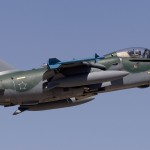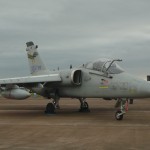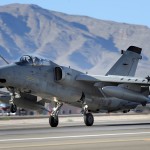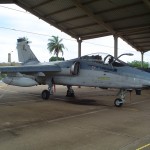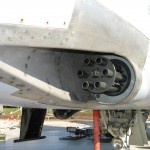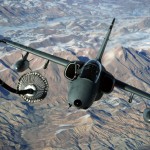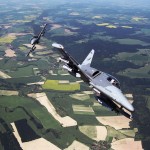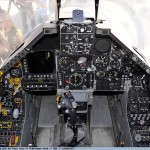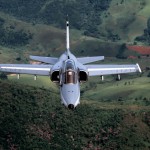
The AMX, known as the A-1 in Brazil, is an impressive ground attack craft developed in a Italian-Brazilian joint venture among Alenia, Embraer, and Aermacchi.
It is a high-performing, modern platform that is perfect for its stated mission of low-level attack, close air support, and battlefield strafing.
The AMX is subsonic but can fly day or night and operate out of rough or damaged airbases. It features an ahead-of-its-time design that feels more like the 1990s than early 1980s. The AMX features both a low infrared signature and reduced radar cross section that makes it difficult to target the plane with ground-to-air or air-to-air missiles. It comes equipped with electronic countermeasures, wingtip air-to-air missiles, and nose-mounted guns that lets it hold its own against other aircraft. It also features carbon fiber parts like the fin and elevators.
By the late 70s, the Italians were looking for an attack fighter to replace its Aeritalia G.91s and F-104 “Starfighters.” Rather than compete — again — on a ground attack jet, Aeritalia and Aermacchi decided to join forces. In 1980, Brazil was looking for a very similar plane. So in July 1981, Italy and Brazil agreed on a set of specifications both countries were looking for, and Brazilian aerospace firm Embraer was brought into the fold.
The resulting rugged design features high-mounted wings, leading edge slats, trailing edge flaps, and overwing spoilers to make the AMX take off and land easier and make the plane more maneuverable.
The AMX has a redundant control system that is a hybrid of modern fly-by-wire technology and hydraulics. The rudder, tailplane, and spoilers are digital, while the ailerons and elevators are hydraulic. The ailerons, elevators, and rudder can operate manually if systems or hydraulics are lost.
The plane is not particularly fast, topping off at just under 570 mph, but it doesn’t have to be. In filling a similar role to the earlier Su-25 “Frogfoot” or American A-10 “Warthog,” the AMX has to be able to fly low and slow through a theatre of operations, taking out designated ground targets and providing support to troops on the ground.
As a result, an aged Rolls-Royce Spey 807 turbofan, similar to one of the four that powers the Hawker Siddeley Nimrod proved to be an effective, reliable, and affordable alternative to American engines, which come with rigid export restrictions.

The first AMX prototype flew in 1984, though it was destroyed in a crash on the fifth test flight, killing its pilot. Despite the setback, the airplane proved reliable, and Italy took its first deliveries in 1988. Brazil followed in 1989, and 200 AMXs have been built to date.
Today, the Brazilian Air Force operates 60 AMXs with eight trainers. The Italian Air Force has a fleet of 43 AMXs and 12 AMX-T trainers.
Success in battle
You don’t hear about the AMX’s war success with the same dramatic flair that journalists herald the A-10 and its Avenger cannon or the Su-25, battling it out in Afghanistan with rockets. But the AMX has proved itself a workhorse in battle.
Six AMX fighters from Italy deployed to Bosnia twice in the 1990s. Italy also sent the AMX to Kosovo in 1999. Here, using Israeli-engineered “Opher” guidance kits, traditionally “dumb” Mk 82s were converted to infrared-guided bombs and were very accurate. AMXs flew 252 combat sorties over Kosovo without a single lost aircraft.
“The AMX series of aircraft under the Italian banner saw extensive — and often overlooked — service int he war against Serbia,” wrote the website Military Factory in its AMX sheet. “All in all, the AMX International AMX is quite a worthy adversary.”
The Italian AMX also saw action in the 2011 Libyan uprising. Italian Tornados and AMX fighters launched more than 550 bombs and missiles during the campaign.
In recent years, Italy and Brazil have separately launched initiatives to upgrade the AMX. In 2005, Italy launched Aggionamento Capacità Operative e Logistiche — Operational and Logistical Capacity Upgrade on 55 of its AMXs, adding smart bomb guidance and new cockpit displays.
Brazil is rolling out the A-1M variant with advanced radar and data sharing, as well as an infrared smart bomb guidance and a glass cockpit. The first A-1M prototype flew on June 20, 2012.
The Brazilian upgrade was originally scheduled to roll out in 2007, but was delayed.
Brazil, in a news report, says the upgrade is necessary “after strategic assessments and is necessary for the aircraft to compete with other countries in case of external threats.”
The upgrades may raise the exportability of the AMX. In 1999, Venezuela tried to buy several AMXs from Brazil, but the sale was halted after US intervention. The Philippines is reportedly exploring the AMX as part of a recently signed defense deal with Italy.
Specifications
General
Crew: One-Two depending on variant (Two in AMX-T trainer)
Length: 43 ft 5 in
Wingspan: 29 ft 1.5 in
Height: 14 ft 11.25 in
Empty weight: 14,771 lb
Max. takeoff weight: 28,700 lb
Engine: One Rolls-Royce Spey 807 turbofan, 11,030 lbf
Performance
Maximum speed: 568 mph
Combat radius: 553 mi
Range: 1,800 nmi
Ceiling: 42,650 ft
Thrust/weight: 0.47
Armament
Guns:
- One 20 mm M61 Vulcan 6-barreled gatling cannon (Italy)
- Two 30 mm Bernardini Mk-164 cannon (Brazil)
Missiles: Two AIM-9 Sidewinders or comparable air-to-air missiles
Bombs/Rockets: 8,380 lb on five hardpoints
Essential Reading
We can’t recommend any actual books that are written about the AMX. There are a few that discuss the AMX. and we’ve singled out the best ones to the right.
Online Resources:
- Milavia — Great photos
- AirFighters.com — Even better photos
- Wikipedia
